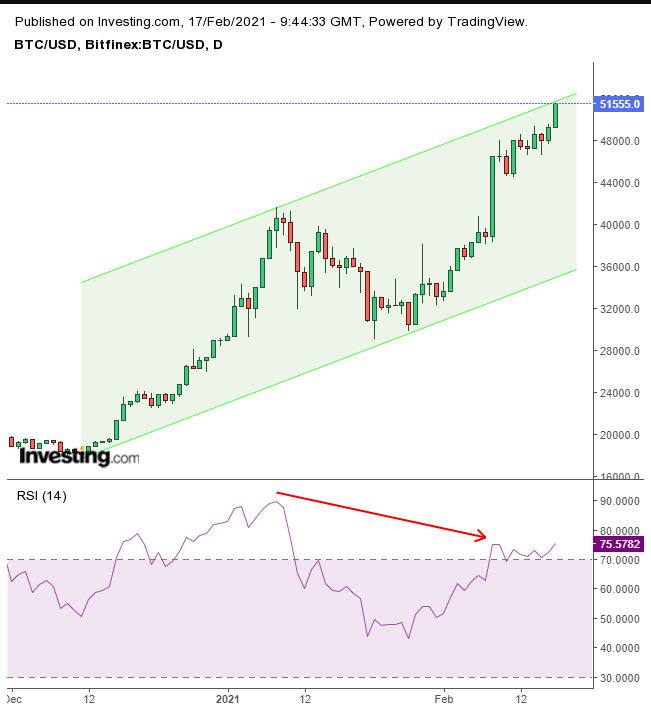Yesterday, for the first time ever, Bitcoin traded above the $50,000 level intraday. Crypto enthusiasts are predicting that this time, the largest digital currency by market cap is just at the beginning of its upward trajectory.
In their view, this time is different than the last time BTC took off, when it reached the $20K level in late 2017 before dropping into a more-than year-long crypto winter. However, the 'now things are different' argument sets our market senses on edge.
To be fair, the current environment has changed in two major ways:
- The state of the economy, and
- Increased acceptance of the cryptocurrency asset class
Unprecedented amounts of stimulus, including in the US, used to counter the global economic distress caused by the coronavirus pandemic, is expected to trigger inflation for the first time in 12 years. That would proportionately lower the dollar’s yield, incentivizing investors and savers to store value in some other form. During December 2017, when Bitcoin topped out, the Dollar Index was at 94.00. Now it’s below 91.
Still, even today, when the dollar gapped up, Bitcoin has moved past $51K at time of writing, once again breaking new ground.
As well, there continues to be vociferous debate around the claim that Bitcoin is siphoning away safe haven demand from gold. But the digital token striking a new all-time high—and trading at the top of the day while doing so—even as the precious metal is dropping on dollar strength, may be bolstering the case that the cryptocurrency, which has been dubbed digital gold by many is, at least now, usurping the yellow metal's haven standing.
Add to that what looks to be a broad, investor re-evaluation of the new asset class. In 2017 many considered Bitcoin to be largely a gimmick, or a naïve dream among starry-eyed young people looking to supplant fiat currencies.
Now, institutions are warming to Bitcoin and the crypto asset class. During September 2017, Ray Dalio, billionaire founder of Bridgewater Associates, the world’s largest hedge fund, said BTC was “not an effective storehold of wealth because it has volatility to it, unlike gold.”
This year, however, on Jan. 30 Dalio reversed course. “I greatly admire how Bitcoin has stood the test of 10 years of time” he said, adding:
“It seems to me that Bitcoin has succeeded in crossing the line from being a highly speculative idea that could well not be around in short order to probably being around and probably having some value in the future.”
Adding heft to the case for Bitcoin was the Feb. 8 revelation that Tesla (NASDAQ:TSLA) had invested $1.5 billion in the cryptocurrency, and that the company planned to accept it as a form of payment in the future. Not a big surprise, to be sure, since the electric vehicle manufacturer's founder and CEO, Elon Musk, has been a crypto proponent for quite some time.
Dalio still warns that Bitcoin is extremely volatile and that investors could lose 80% of their investment if volatility continues. He even went as far as saying that countries around the world could outlaw the digital currency if it continues to rise.
It's ironic that for older, more accepted assets market tops are usually signaled when retail investors jump in. However, for this newest asset class it would appear that a top could be at hand when institutional, 'smart money' joins the party. Therefore, we’re issuing a warning that Bitcoin is overheated and looking like it needs to refuel.

While the price of Bitcoin has been rising, its momentum has been slowing, displaying weakness in the uptrend, a signal for a potential pullback. As well, the RSI above 70 indicates it's overbought.
Trading Strategies
Conservative traders should wait for a meaningful decline, to at least $40,000, to test the most recent uptrend line since the December low, with evidence of accumulation.
Moderate traders would buy Bitcoin on accumulation after a dip, or risk a small position upon a return to the $40K level, without signs of support.
Aggressive traders could enter a contrarian trade after a bearish counterattack, with at least one long, red candle erasing the previous day’s advance. Then, depending on your risk tolerance, you could wait for the price to retest the previous day’s highs for a better entry, if not to retest resistance. Or you can short immediately. The more aggressive the position, the tighter the trade plan must be.
Here’s what to consider:
Trade Sample – Short Position Setup
- Entry: $50,000
- Stop-Loss: $52,000
- Risk: $2,000
- Target: $40,000
- Reward: $10,000
- Risk:Reward Ratio: 1:5
Author's Note: This sample is not a trade signal. It is only an estimate of what a current reversal might look like based on our interpretation of the chart. The actual analysis is in the Trading Strategies section. Even if we’re right, any one trade plan may fail. And we might be wrong. Therefore, trading without a plan is like heading into a dangerous jungle without a map. Your timing, budget and temperament must be reflected in your plan. Practice with small amounts, until you learn how to do that.
